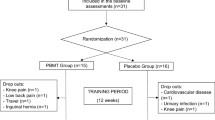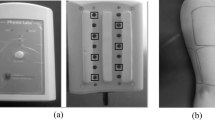Abstract
The aim of this study was to compare the effects of resistance training of low volume and high intensity with or without photobiomodulation (PBM) on muscle strength and functional performance in post-menopausal women. Thirty-four post-menopausal women were randomized into resistance training (RTG, n = 17) or resistance training plus PBM (PBMG, n = 17). Individuals from both groups received the same RT protocol consisting of leg-press 45°, front lat pulldown, leg curl, chest press, and squat performed in two sets of 10 repetitions with a workload of 75% of one repetition maximum (1RM), twice per week, during 8 weeks. PBMG individuals also received, prior to the exercise session, PBM through a cluster containing 7 visible diodes (630 nm) and 7 infrared diodes (850 nm) with power of 100 mW each and energy of 4 J per diode, applied to the quadriceps femoris muscle; individuals from RTG received placebo PBM prior to the sessions, applied with the same device switched off. Muscle strength (1RM; isometric dynamometer), functional performance (Time Up and Go; Berg Balance Scale; 6-min walk test), and quality of life (World Health Organization Quality of Life-Bref) were performed before and after 8 weeks. Both groups increased muscle strength (p < 0.001) for all exercises, without group differences (p = 0.651). Quality of life (p = 0.015) and balance (p = 0.006) increased only in the RTG. The results suggest that PBM were not able for inducing additional benefits to RT to improve muscle strength in post-menopausal women.




Similar content being viewed by others
References
Gladyshev VN (2016) Aging: progressive decline in fitness due to the rising deleteriome adjusted by genetic, environmental, and stochastic processes. Aging Cell 15:594–602
Delmonico MJ, Harris TB, Visser M et al (2009) Longitudinal study of muscle strength, quality, and adipose tissue infiltration. Am J Clin Nutr 90:1579–1585. https://doi.org/10.3945/ajcn.2009.28047
Dirks ML, Wall BT, Kramer IF et al (2016) A single session of neuromuscular electrical stimulation does not augment postprandial muscle protein accretion. Am J Physiol Endocrinol Metab 311:E278–E285. https://doi.org/10.1152/ajpendo.00085.2016
Lang T, Streeper T, Cawthon P et al (2010) Sarcopenia: etiology, clinical consequences, intervention, and assessment. Osteoporos Int 21:543–559. https://doi.org/10.1007/s00198-009-1059-y
Kulasingam S, Moineddin R, Lewis JE, Tierney MC (2008) The validity of the Menopause Specific Quality of Life Questionnaire in older women. Maturitas 60:239–243. https://doi.org/10.1016/j.maturitas.2008.07.002
Baudry S, Klass M, Pasquet B, Duchateau J (2007) Age-related fatigability of the ankle dorsiflexor muscles during concentric and eccentric contractions. Eur J Appl Physiol 100:515–525. https://doi.org/10.1007/s00421-006-0206-9
Rolland Y, Czerwinski S, Van Kan GA et al (2008) Sarcopenia: Its assessment, etiology, pathogenesis, consequences and future perspectives. J Nutr Health Aging 12:433–450. https://doi.org/10.1007/BF02982704
Ratamess NA, Alvar BA, Evetoch TK et al (2009) Progression models in resistance training for healthy adults. Am Coll Sport Med 41:687–708
Lopes WA, Leite N, Da SLR et al (2016) Effects of 12 weeks of combined training without caloric restriction on inflammatory markers in overweight girls. J Sports Sci 0:1–11. https://doi.org/10.1080/02640414.2016.1142107
Orsatti FL, Nahas EAP, Maesta N et al (2008) Plasma hormones, muscle mass and strength in resistance-trained postmenopausal women. Maturitas 59:394–404. https://doi.org/10.1016/j.maturitas.2008.04.002
Friedenreich CM, Neilson HK, Wang Q et al (2015) Effects of exercise dose on endogenous estrogens in postmenopausal women: a randomized trial. Endocr Relat Cancer 22:863–876. https://doi.org/10.1530/ERC-15-0243
Giessing J, Eichmann B, Steele J, Fisher J (2016) A comparison of low volume “high-intensity-training” and high volume traditional resistance training methods on muscular performance, body composition, and subjective assessments of training. Biol Sport 33:241–249. https://doi.org/10.5604/20831862.1201813
Fisher JP, Steele J, Gentil P et al (2017) A minimal dose approach to resistance training for the older adult; the prophylactic for aging. Exp Gerontol 99:80–86
De Brito Vieira WH, Ferraresi C, De Andrade Perez SE et al (2012) Effects of low-level laser therapy (808 nm) on isokinetic muscle performance of young women submitted to endurance training: a randomized controlled clinical trial. Lasers Med Sci 27:497–504. https://doi.org/10.1007/s10103-011-0984-0
Ferraresi C, Hamblin MR, Parizotto NA (2012) Low-level laser (light) therapy (LLLT) on muscle tissue: performance, fatigue and repair benefited by the power of light. Photonics Lasers Med 1:267–286. https://doi.org/10.1515/plm-2012-0032
Ferraresi C, Huang YY, Hamblin MR (2016) Photobiomodulation in human muscle tissue: an advantage in sports performance? J Biophotonics 9:1273–1299. https://doi.org/10.1002/jbio.201600176
Ferraresi C, De Brito Oliveira T, De Oliveira Zafalon L et al (2011) Effects of low level laser therapy (808 nm) on physical strength training in humans. Lasers Med Sci 26:349–358. https://doi.org/10.1007/s10103-010-0855-0
Vieira WHB, Bezerra RM, Queiroz RAS et al (2014) Use of low-level laser therapy (808 nm) to muscle fatigue resistance: a randomized double-blind crossover trial. Photomed Laser Surg 32:678–685. https://doi.org/10.1089/pho.2014.3812
Ferraresi C, Kaippert B, Avci P et al (2015) Low-level laser (light) therapy increases mitochondrial membrane potential and ATP synthesis in C2C12 myotubes with a peak response at 3–6 h. Photochem Photobiol 91:411–416. https://doi.org/10.1111/php.12397
Toma RL, Tucci HT, Antunes HKM et al (2013) Effect of 808 nm low-level laser therapy in exercise-induced skeletal muscle fatigue in elderly women. Lasers Med Sci 28:1375–1382. https://doi.org/10.1007/s10103-012-1246-5
Toma RL, Vassão PG, Assis L et al (2016) Low level laser therapy associated with a strength training program on muscle performance in elderly women: a randomized double blind control study. Lasers Med Sci 31:1219–1229. https://doi.org/10.1007/s10103-016-1967-y
Maciel S, Solange I, Muñoz S et al (2014) Phototherapy effect on the muscular activity of regular physical activity practitioners. Lasers Med Sci:1145–1152. https://doi.org/10.1007/s10103-013-1481-4
Schulz KF, Altman DG, Moher D (2010) WITHDRAWN: CONSORT 2010 statement: updated guidelines for reporting parallel group randomised trials. Int J Surg 115:1063–1070. https://doi.org/10.1016/j.ijsu.2010.09.006
Vanin AA, Miranda EF, Machado CSM et al (2016) What is the best moment to apply phototherapy when associated to a strength training program? A randomized, double-blinded, placebo-controlled trial: Phototherapy in association to strength training. Lasers Med Sci:1–10. https://doi.org/10.1007/s10103-016-2015-7
Berin E, Hammar ML, Lindblom H et al (2016) Resistance training for hot flushes in postmenopausal women: randomized controlled trial protocol. Maturitas 85:96–103. https://doi.org/10.1016/j.maturitas.2015.12.015
Caserotti P, Aagaard P, Buttrup Larsen J, Puggaard L (2008) Explosive heavy-resistance training in old and very old adults: changes in rapid muscle force, strength and power. Scand J Med Sci Sports 18:773–782. https://doi.org/10.1111/j.1600-0838.2007.00732.x
Baechle TR, Earle RW (2000) Essentials of strength training and conditioning. In: Essentials of strength training and conditioning, 2rd ed. Human Kinetics Publishers, Illinois, p 658
Martin HJ, Yule V, Syddall HE et al (2006) Is hand-held dynamometry useful for the measurement of quadriceps strength in older people? A comparison with the gold standard biodex dynamometry. Gerontology 52:154–159. https://doi.org/10.1159/000091824
Prestes J, Nascimento C, Tajra V et al (2015) Understanding the individual responsiveness to resistance training periodization. 4. https://doi.org/10.1007/s11357-015-9793-x
Miyamoto ST, Lombardi I, Berg KO et al (2004) Brazilian version of the Berg balance scale. Braz J Med Biol Res 37:1411–1421. https://doi.org/10.1590/S0100-879X2004000900017
Park S-H (2017) Tools for assessing fall risk in the elderly: a systematic review and meta-analysis. Aging Clin Exp Res 0(0). https://doi.org/10.1007/s40520-017-0749-0
Fleck MP, Louzada S, Xavier M et al (2000) Application of the Portuguese version of the abbreviated instrument of quality life WHOQOL-bref. Rev Saude Publica 34:178–183
Vassão PG, Toma RL, Antunes HK et al (2016) Effects of photobiomodulation on the fatigue level in elderly women: an isokinetic dynamometry evaluation. Lasers Med Sci 31(2): 275–282. https://doi.org/10.1007/s10103-015-1858-7
Fu Y, Karsten B, Larumbe-Zabala E et al (2017) Comparison of two equated resistance training weekly volume routines using different frequencies on body composition and performance in trained males. Appl Physiol Nutr Metab 43(5):475–481. https://doi.org/10.1139/apnm-2017-0575
Nunes PRP, Oliveira AA, Martins FM et al (2017) Effect of resistance training volume on walking speed performance in postmenopausal women : a randomized controlled trial. Exp Gerontol 97:80–88. https://doi.org/10.1016/j.exger.2017.08.011
Fisher JP, Steele J, Gentil P et al (2017) Mini review a minimal dose approach to resistance training for the older adult; the prophylactic for aging. Exp Gerontol 99:80–86. https://doi.org/10.1016/j.exger.2017.09.012
Folland JP, Williams AG (2007) The adaptations to strength training increased strength. Sport Med 37:145–168. https://doi.org/10.2165/00007256-200737020-00004
Fry a C (2004) The role of resistance exercise intensity on muscle fiber adaptation. Sports Med 34:663–669. https://doi.org/10.2165/00007256-200434100-00004
Peterson MD, Rhea MR, Sen A, Gordon PM (2010) Resistance exercise for muscular strength in older adults: a meta-analysis. Ageing Res Rev 9:226–237. https://doi.org/10.1016/j.arr.2010.03.004
De Siqueira M, Barbalho M, Gentil P et al (2017) There are no no-responders to low or high resistance training volumes among older women. Exp Gerontol 99:18–26. https://doi.org/10.1016/j.exger.2017.09.003
Papa EV, Dong X, Hassan M (2017) Resistance training for activity limitations in older adults with skeletal muscle function deficits: a systematic review. Clin Interv Aging 12:955–961
Borsa PA, Larkin KA, True JM (2013) Does phototherapy enhance skeletal muscle contractile function and postexercise recovery? A systematic review. J Athl Train 48:57–67. https://doi.org/10.4085/1062-6050-48.1.12
Leal-junior ECP, Vanin AA, Miranda EF et al (2015) Effect of phototherapy (low-level laser therapy and light-emitting diode therapy) on exercise performance and markers of exercise recovery: a systematic review with meta-analysis. Lasers Med Sci 30(2): 925–939. https://doi.org/10.1007/s10103-013-1465-4
Nampo FK, Cavalheri V, Soares S (2016) Low-level phototherapy to improve exercise capacity and muscle performance: a systematic review and meta-analysis. Lasers Med Sci:1957–1970. https://doi.org/10.1007/s10103-016-1977-9
De Marchi T, Schmitt VM, Fabro S, et al. (2017) Phototherapy for improvement of performance and exercise recovery: comparison of 3 commercially available devices. J Athl Train 52:429–438. https://doi.org/10.4085/1062-6050-52.2.09
Author information
Authors and Affiliations
Corresponding author
Ethics declarations
Conflict of interest
The authors declare that they have no conflict of interest.
Ethical approval
All procedures performed in studies involving human participants were in accordance with the ethical standards of the institutional and/or national research committee and with the 1964 Helsinki declaration and its later amendments or comparable ethical standards.
Additional information
Publisher’s note
Springer Nature remains neutral with regard to jurisdictional claims in published maps and institutional affiliations.
Rights and permissions
About this article
Cite this article
Almeida, J.N., Prado, W.L., Terra, C.M. et al. Effects of photobiomodulation on muscle strength in post-menopausal women submitted to a resistance training program. Lasers Med Sci 35, 355–363 (2020). https://doi.org/10.1007/s10103-019-02822-4
Received:
Accepted:
Published:
Issue Date:
DOI: https://doi.org/10.1007/s10103-019-02822-4




